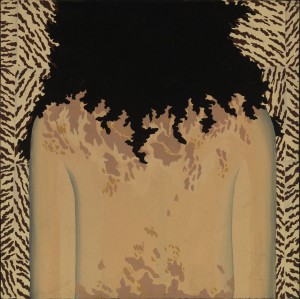Metamorphosis: Christina Ramberg and the Imagists
These days, the Chelsea galleries are often more concerned with commerce than art, so it’s refreshing to find a show that, however small, puts high value on politics, irreverence, humor – and social change.
On the north border of the gallery district, there is a handful of art dealers who are determined that art not only be for sale, but that it also be informed by the somewhat outdated notions of message, talent, and originality. Christina Ramberg: Corset Urns and Other Inventions, 1968-1980, now at the David Nolan Gallery in New York City, showcases fantastic feminist images, and sparks a lively visual conversation about the place of those images both in an emerging culture of feminism and within the larger pantheon of visual history.
Ramberg, born in the 1940s, came early to the pop/feminist camp. She got her B.F.A. and M.F.A. from the School of the Art Institute of Chicago in the 1960s and early 1970s, where she studied with Ray Yoshida. Yoshida encouraged the use of commercial and pop imagery, which spawned a group called The Imagists. Their work differed from the coolness of the New York and European Pop Artists with figurative paintings and drawings in high, saturated color. Plundering the pages of comic books, periodicals and lingerie catalogues for material, Ramberg joined with artists like Ed Paschke, Roger Brown, Jim Nutt and Gladys Nisson as the front line of a truly American Pop Art that had shock value for its sexiness and no-holds-barred rebelliousness.
Ramberg’s images have a stark simplicity to them (none of the bodies have faces), which, if they were not so urgently incomplete, would render them annoyingly didactic. The sketches read like quickly made “to do” lists to be mined for larger work – should the bra be on this way or that way; do the high heels enhance or cripple; do the fingernails mean something different with or without polish? There is a struggle about what to do with a newly-liberated female body: hair goes in every direction, underwear becomes a medieval torture device, and, especially in the paintings, no figure is in clothing that quite fits or is worn correctly. Although the majority of the figures are identified as women, there is an androgynous feel to them, something undefined.
In Corset Urns, 1975, an eight-piece painting, generally considered Ramberg’s masterpiece, the line between the vessel and what is being contained is completely wiped out, implying an ongoing metamorphosis and dialogue. The paintings feel deeper and darker than the drawings; according to the gallery, they were done at night which adds to their deep, reserved quality. This work is, as the title of the exhibit suggests, invention in a shifting era; at its most simplistic, it is the artist inventing herself in the context of roiling social change.
Ramberg died in the mid-90s from complications of a degenerative neurological disease; she had stopped making work in the early 1980s. Her reputation is gaining ground within the Imagists and in the world at large. The Art Institute of Chicago showed a whole room of Ramberg in recent years, and David Nolan, who also shows Jim Nutt, is working hard to erase the tendency of the critical community to shout “regionalism” when discussing these Chicago artists. First and foremost, the show spotlights that there were talented females who were key in the Imagist movement.
“There were very few women within the Imagists,” said Katherine Chan, director of the gallery. “This was an opportunity to show that they had an equally strong voice.”
The show is open until January 21. For more information visit http://www.davidnolangallery.com.


